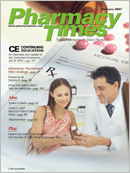Publication
Article
Pharmacy Times
The Value of Pharmacists
It's budget development time again!This is an exciting time for directorsof pharmacy, because this processrepresents the best opportunity for thedepartment to request additional staffin order to launch new programs orimprove existing programs. Although itreally is exciting, it is frustrating at thesame time, in that considerable supportusually comes from pharmacyleaders, medical staff, nursing staff, andothers for the recommended changesproposed by pharmacy, but that supportis rarely enough to justify the additionof new positions. Thus, if the proposedstaff additions are not approved,the director of pharmacy is obliged toexplain why the new positions are notapproved to all those who understandthe need.
At the University of North CarolinaHospitals, the strongest supporters arethe medical staff. Their historical experiencein collaborating with pharmacistshas rendered them believers. The pharmacist'sdrug therapy acumen optimizescare, enhances efficiency andaccuracy, is invaluable in medical residenttraining, and promotes cost-effectivecare. When pharmacy staffs arereadily available, they make a positivedifference in the patient care process.During the past year, we havecontributed to enhancingthroughput and improvingpatient safety and haveimproved patient satisfaction.Overall, our pharmacistsenjoy positions thatencompass responsibilitiesthat engender high satisfaction,and, thus, turnover islow.
Despite all of these successes—a positive trackrecord in terms of the overallfinancial performance of thedepartment—we never getall of our requests approved.
Again, new programs willbe evaluated on expensereductions that can be substantiatedor new revenuethat can be generated. The dilemma isthat we contribute to improvements infinancial performance, patient safety,patient and staff satisfaction, and optimaldrug therapy outcomes, but differentiatingour impact, compared withthat of other providers, is virtuallyimpossible. Benchmarking our effectivenesshelps, and our leadershipunderstands that we are effective inpromoting cost-effective care, but ourpast performance in all of theseadvancements is now a baselineexpectation, and the assumption isthat, like drug distribution and basicpharmacy systems and processes, weshould be able to do more with less.
Like many of my peers, we are doingall we can to pull together data that willsubstantiate our needs from all perspectivespossible. My experience, however,is that unless financial implicationshave a net positive impact, our probabilitiesof success are marginal. It isbecoming undeniable that we need todevelop a strategy that enables our staffto charge for their services. This cannotbe accomplished at a local level. It willrequire engagement with governmentagencies, private payers, and mostimportantly, patients (who can have agreat impact on influencing payers).
How will this advocacy processoccur? It will require a carefully constructedstrategic plan, data collectionfrom multiple environments that isreproducible, and engagement of high-leveldecision makers who can influencepublic policy. We all know the value ofpharmacists. Our challenge is how toeffectively educate decision makers toinvest in professional evolution.
Mr. McAllister is director of pharmacyat University of North Carolina (UNC)Hospitals and Clinics and associatedean for clinical affairs at UNCSchool of Pharmacy, Chapel Hill.







